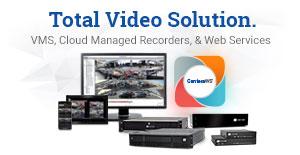Video analytics at the edge is transforming the industry

Needless to say, edge computing has become a major trend. Processing data at the edge lowers bandwidth consumption and reduces communication latency, allowing end users to make faster decisions in critical situations. In video surveillance, edge computing primarily refers to processing data in the camera itself, which carries various benefits.
Edge computing has become a more popular and widespread concept among end user entities. Whereas it takes 150 to 200 milliseconds for data to travel from endpoints to the cloud, it takes just 10 milliseconds from endpoints to edge. This allows for more effective detection and response in various verticals, for example manufacturing.
Edge computing benefits in video surveillance
In video surveillance, edge computing takes the form of processing video data within the camera itself rather than on the backend. Thanks to advances in technology, today’s IP cameras increasingly have the processing power to run AI- or deep learning-based analytics and algorithms such as facial recognition. There are a lot of benefits of processing data on the camera, and they can be summarized as follows.
Lower bandwidth consumption
A major benefit, needless to say, is bandwidth usage reduction. “Edge computing performs data processing at the ‘edge’ of the network, near the source of the data. Doing so could significantly reduce the bandwidth needed between sensors and devices and the data center if only specific events and short sequences of video need to be transported,” said Mats Thulin, Director Core Technologies at Axis Communications. “In many installations the network bandwidth is a limitation and therefore the video is heavily compressed. Doing advanced video analytics on a heavily compressed video reduces the accuracy of the analytics, and therefore processing on the original data at the edge has clear advantages.”
“When advanced processing takes place on the backend, all streams to be analyzed must be transmitted to the server(s). Moving that processing to the edge enables solutions that are more selective regarding what gets transmitted across bandwidth limited links,” said Dave Staudacher, System Architect at Pelco.
“With AI algorithms woven into the edge devices, only selected information such as an individual or a vehicle in a video image will be extracted and sent. This enhances the transition efficiency significantly and reduces the network bandwidth load, while sustaining high quality and accuracy,” said Max Fang, IP Project Product Director at Hikvision.
Faster response
Another major benefit of computing in the camera is latency reduction. Rather than sending the video to the backend for processing and analysis, a camera with facial recognition capabilities, for example, can recognize an unwanted or suspicious person and immediately send an alarm to the alarm device. “Detecting significant situations at the edge enables solutions that use local responses, versus requiring round trips to backend servers,” Staudacher said.
“There is the potential for significant latency in getting alarms when relying on a backend server for data processing. However, this risk is reduced when edge computing is done in the camera,” said Lei Bennett, VP of Product Management for Security at FLIR Systems.
A hybrid approach
However, this is not to negate the need for cloud computing. In fact, a hybrid approach may be a more ideal solution. “The best edge computing-based surveillance systems combine with cloud solutions, rather than being a competitor. Recording occurs locally as needed on the edge, across the network on a NVR/DVR, and can be uploaded, shared, and managed from anywhere over the cloud. Legacy surveillance systems don’t match these many benefits in cost savings, staff reduction, and mobility,” said Jeff Whitney, VP of Marketing at Arecont Vision Costar.
“As network cameras, audio and other sensors – the devices on the edge of the network – become ever more sophisticated and of higher quality, the need to balance both cloud computing and edge computing domains will be imperative to deliver refined, reliable and usable data. Neither cloud nor edge will win out over the other; the solution will be a combination of the two,” Thulin said.
















